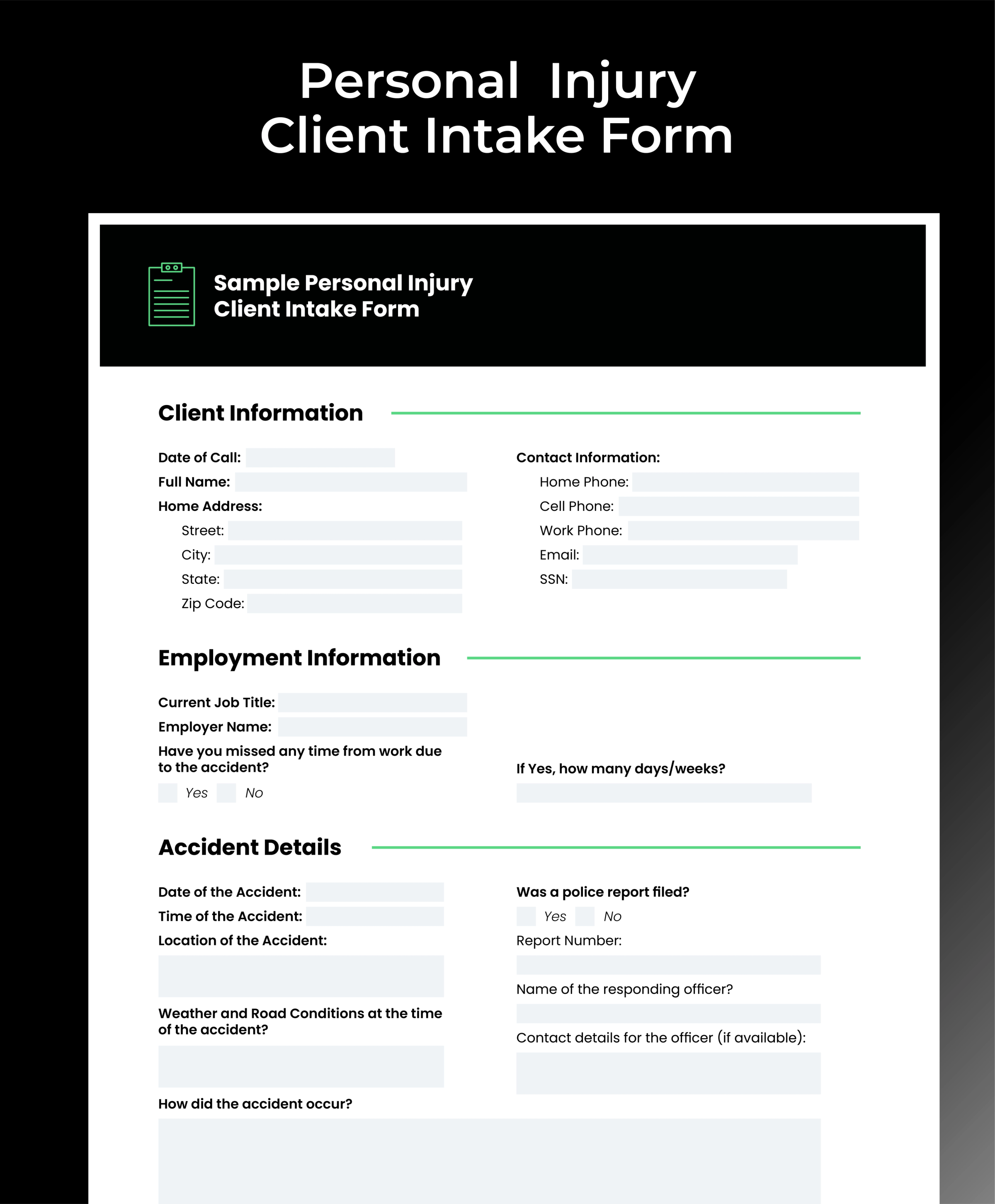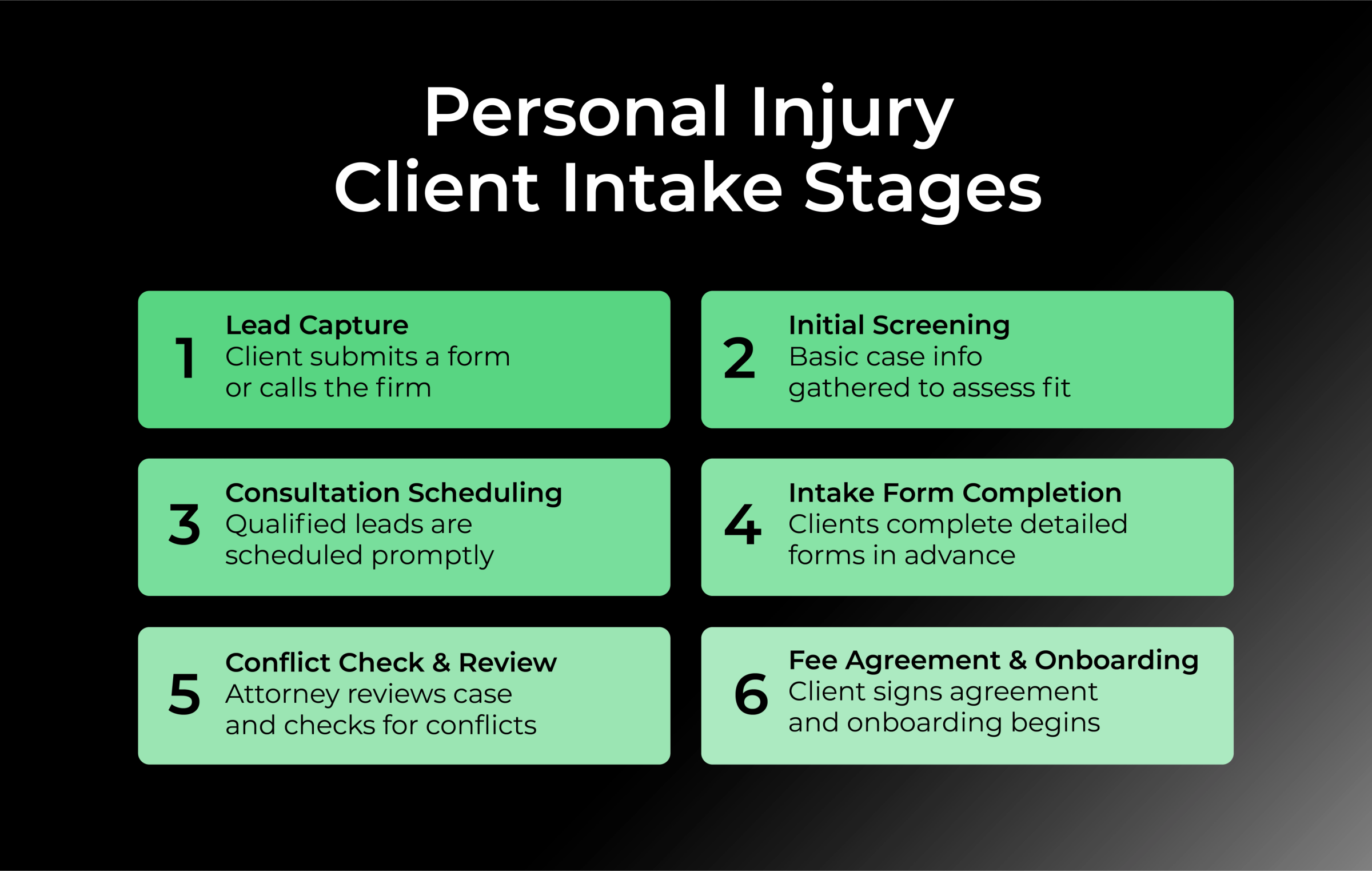Key takeaways
Intake is more than collecting information—it establishes a foundation for a successful client relationship.
Effective intake forms feature simple but thorough sections covering client, accident, and injury details.
Optimizing your personal injury intake process can deliver far-reaching business benefits.
Want to upgrade your law firm's operational, financial, and client satisfaction performance? Consider modernizing your intake process.
A well-structured personal injury intake process, supported by a clean and logical intake form, is essential for evaluating prospective cases, making positive impressions with new clients, and converting high-quality leads.
After all, intake sets the tone for the client’s relationship with your firm. Done right, the process encourages clients to share their stories and creates a foundation for winning legal representation.
This thorough guide includes a downloadable intake form and the fundamental strategies for designing a scalable intake process that supports positive case outcomes. Implement the form and best practices at your law firm to improve client conversions, intake accuracy, and operational efficiency.
Download Your Free Personal Injury Intake Form
When you’re juggling clients, cases, and a mountain of paperwork, the last thing you want is a messy intake process. Add structure to your client onboarding with our free personal injury client intake form for car accident cases. The form incorporates personal injury intake best practices to gather:
Client name and contact information
Client employment information
Accident details, including location, weather, and road conditions
Name, contact, insurance, and vehicle information for the other driver
Medical information, including injury description
Witness information
Client vehicle and car insurance details
Client statement on how the injury is impacting daily life
Property damage information and notes
Download our free personal injury client intake form now for a quick, easy upgrade to your intake process.

Why Use a Standardized Personal Injury Intake Form?
Standardized intake forms benefit you and your clients by:
Ensuring consistency: Your team will gather consistent, accurate details from every client.
Saving time: A strategically crafted online form collects the information at the client's convenience. Follow-up conversations should be minimal, which streamlines the process for your team and your clients.
Thorough, organized case evaluations: Consolidating case details on one form makes it easier to decide if the case is worth pursuing.
What to Include in a Personal Injury Intake Form
You need all the facts to evaluate and represent a case, but requesting too many details at intake can burden your prospective clients. A well-crafted intake form finds the balance by collecting only the necessary information. The list below is a solid starting point that you can customize to suit your practice.
Basic Information
The client's name, contact information, and the estimated loss date are critical datapoints to collect upfront—ideally, in the lead or prequalification stage. In these early conversations, you can also cover accident and injury details, witness names and contact numbers, insurance information, and medical provider names and telephone numbers.
Accident Description
For the sake of accuracy, gather your client's account of the accident as soon as possible. The passing of time tends to blur memories and details. For example, on the day of the accident, the client may remember driving 45 miles per hour just before impact. But a few days later, they may remember a different speed or may have forgotten it entirely.
A customized intake form that includes input for the accident type and details can help you prompt the client for small but relevant data points. Examples include where the client felt the pressure of the seatbelt, whether there was more than one impact, and what the defendant said at the scene.
Witness Details
Witnesses can make or break a case. If someone else saw or heard the accident, you must gather that person's account. The defense certainly will. Make sure you have witness contact information by requesting it on the intake form.
Injury Details
Injuries can form the primary justification for the demand amount. Your ability to estimate damages, including future medical costs, begins with a detailed understanding of your client's injuries. Consider adding a series of questions about pain and/or diagnosed injuries. A diagram of the human body that the client can label may be useful.
Insurance Information
The intake form should request insurance information for the client and the defendant, including provider name, policy number, and policy limits if available. The insurance details help you evaluate where the settlement funds may come from between the client's policy and the defendant's policy.
Legal History Check
A prospective client may have a problematic legal history, such as prior involvement in multiple personal injury demands. Understanding that history upfront helps you evaluate the case more accurately. For this reason, your intake form should ask the client to describe any prior lawsuits and claims.
Signature and Consent
For legal compliance, request the client's signature and formal consent to proceed on the intake form. You can automate this by adding e-signature capabilities to your forms. CASEpeer has this functionality. With CASEpeer's e-signature feature, you can manage intake forms as well as contracts, contingency fee agreements, and releases directly from your case management application.
Tips for Crafting Intake Forms
Intake forms collect many necessary details from the client. The complexity can easily end up being overwhelming for the client. Follow the four tips below to ensure a great experience and minimize form fatigue:
Keep it simple: Avoid jargon and legalese. Keep the language and questions straightforward. The easier the form is for the client to read and understand, the faster it will be completed.
Ensure mobile accessibility: Many clients may choose to complete an intake form on their smartphone. Test your forms to ensure they display properly and work flawlessly on small screens. Text should be readable, and buttons should be large enough to press definitively without overlap. Clean, responsive layouts are best. A responsive design adapts automatically to the screen size.
Organize for flow: Questions and input fields should follow a natural flow. Clients will expect to provide their general information first, accident details second, followed by legal history and document uploads.
Consider multilingual options: Translation support for forms encourages more efficient form completion and a better client experience. Many clients may prefer a form in their native language, regardless of their English proficiency.
Why the Intake Process Is More Than Just a Form
At a personal injury law firm, the intake process goes beyond data collection. It is a conversion system that sets the tone for the entire client relationship. The quality of your intake process affects:
The impression you make on prospective clients
Prospective clients' willingness to engage with your firm and your team
The rate at which leads convert to clients
The expectations clients have once they sign an agreement
The data available to evaluate prospective cases
The data your lawyers have to pursue appropriate compensation for the client
A thorough and optimized intake process supports better case outcomes and shorter case timelines. Over time, faster and more successful case handling translates to improvements in the firm's win rate, reputation, and client satisfaction scores.
Personal Injury Client Intake Process Overview
Optimizing your intake form will create efficiencies and improve the client experience, but you can achieve greater results by rethinking the firm's entire intake process, beginning with the client's first inquiry and ending with signed representation. These are the typical stages of intake:
Lead capture: In lead capture, the client completes an inquiry form on the law firm's website or calls the office directly. Often, the client already has some information about the firm gathered from the website, online reviews, or friends and family.
Initial contact and screening: Your early responses to the client inquiry should seek to gather basic information about the case for a cursory assessment of case fit. For instance, if your team only handles car accidents, you would screen prospective clients by accident type early on.
Consultation scheduling: Clients who pass an initial screening are quickly scheduled for consultations. For best results, send reminders and preparation instructions so clients arrive on time and prepared to discuss their case.
Detailed intake form completion: Next, you'll ask clients to complete a detailed intake form. To encourage thorough form completion, consider sending a digital form to clients ahead of the consultation. Many clients may be more comfortable providing the information from home, at a convenient time, rather than from the waiting room in your office.
Conflict check and case review: Using the information provided on the intake form, a lawyer on your team checks for conflicts and evaluates the case.
Fee agreement and onboarding: If you accept the case and the client wants to move forward, you and the client will execute a fee agreement, and your team will onboard the client.

How to Create a Personal Injury Client Intake Process
The steps of intake noted above do not come together seamlessly on their own. Most firms need to design the right approaches and rely on the right tools so that clients and team members can move easily from one step to the next.
Rely on the five steps below to design a streamlined personal injury client intake process that contributes to your firm's success:
Step 1 – Capture and Qualify New Leads Effectively
An intake management system can help you capture and qualify leads effectively. Look for personal injury intake software that supports integrated, customized inquiry forms you can publish on your website. The system should also allow team members to add leads manually to track leads who call or walk into the office.
Your web forms should allow for customized screening questions. You'll want the same questions documented on a checklist for the team members who handle prescreening.
Ideally, your personal injury intake software will also support task delegation and case file sharing. With these features, the team can prioritize and act on high-value leads quickly.
Step 2 – Use the Right Intake Form
A complete intake form gathers the information your team needs to check for conflicts and evaluate the case, including:
Client information
Accident details
Insurance information for the client and the defendant
Injury description and medical provider contacts
Witness details
Standardized intake forms support a more efficient, uniform process. However, the information you collect may differ slightly across case and accident types. You can achieve both objectives by using a customizable intake form template to build a set of intake forms. This way, each form in the set is optimized for a specific client type, but all collect roughly the same datasets. As a result, your team can work more efficiently while still providing a client-specific experience.
Step 3 – Optimize Your Intake Interactions with Clients
These early conversations are pivotal for your firm's conversion rate and reputation. Rushing through the first phone call or consultation, clients may feel the firm is too busy to represent them. Ensure you and your team members are making positive impressions by following these best practices for intake communications:
Listen and be empathetic: Many of your prospective clients will be managing through traumatic, life-altering events. They need reassurance that they'll be treated with respect. If the intake conversations feel transactional, they are likely to choose a different lawyer.
Immediately capture contact information: Request contact information and the client's preferred method of communication right away. This establishes your intention to follow up and may encourage a faster response from the client.
Be transparent about fees and payment expectations: Clearly communicate how fees are calculated and when they are collected. Share the process for expense reimbursement. And let clients know how often they will receive account statements or invoices.
Emphasizing empathy, responsiveness, and clarity on fees helps build trust during early communications.
Step 4 - Consider Hiring a Dedicated Intake Specialist
A dedicated personal injury intake specialist can boost your firm's conversion rate by ensuring no leads are missed and providing a consistent experience for new clients. Your intake specialist will handle screening, onboarding, and managing leads as they move through the conversion process.
The advantages of having a dedicated personal injury intake specialist include:
Reduces administrative burden for lawyers
Provides a more consistent experience for clients
Establishes more uniform data collection to measure lead production, quality, and conversion
Minimizes confusion among team members about who's responsible for intake responsibilities
Step 5 – Use Software to Automate Your Intake Workflow
Harnessing the power of legal software to automate personal injury intake workflows can be one of your most impactful operational strategies. Personal injury intake software applications like CASEpeer have powerful tools that can save time while improving the client experience. Examples include:
Automated tasks: Make sure every lead receives a follow-up with automated tasks and reminders.
Automated template documents: CASEpeer combines templated language with saved client information to create professional, personalized documents in seconds.
E-Signature functionality: When clients are ready to sign, you can expedite agreement execution with e-signatures. No printing or scanning required.
CASEpeer Streamlines Personal Injury Client Intake
Your law firm's personal injury intake process can do more than collect information. A well-crafted intake form provides structure to the process, establishes your firm's professionalism, creates a stellar client experience, and saves time. An optimized intake form combined with automated lead capture, follow-ups, consultation scheduling, and e-signature capabilities kicks off every client relationship with personalized communications, efficiency, and expertise.
Take the first step in optimizing your intake process by downloading our free personal injury intake form. You may also want to review CASEpeer features, which complement the downloaded form and take your intake process to a new level of efficiency.
With CASEpeer, you can:
Create secure personal injury intake forms and manage them online.
Provide easy new client onboarding with eSignatures.
Easily and securely communicate with clients via a client portal.
Keep client info stored safely and in one place, making personal injury case management smoother than ever.
Request a demo now and see how CASEpeer can supercharge your intake process.
